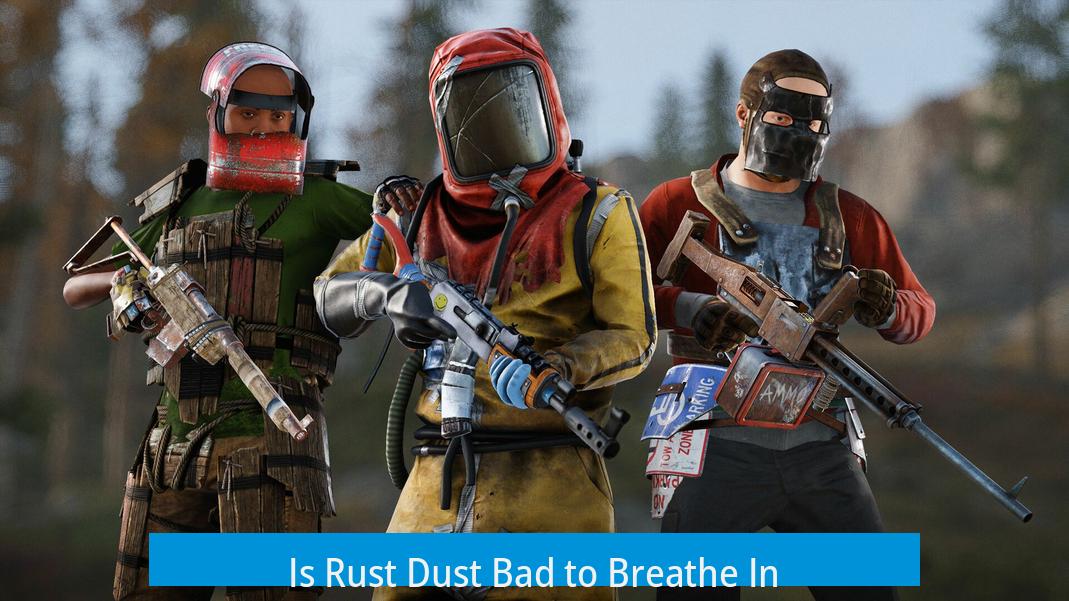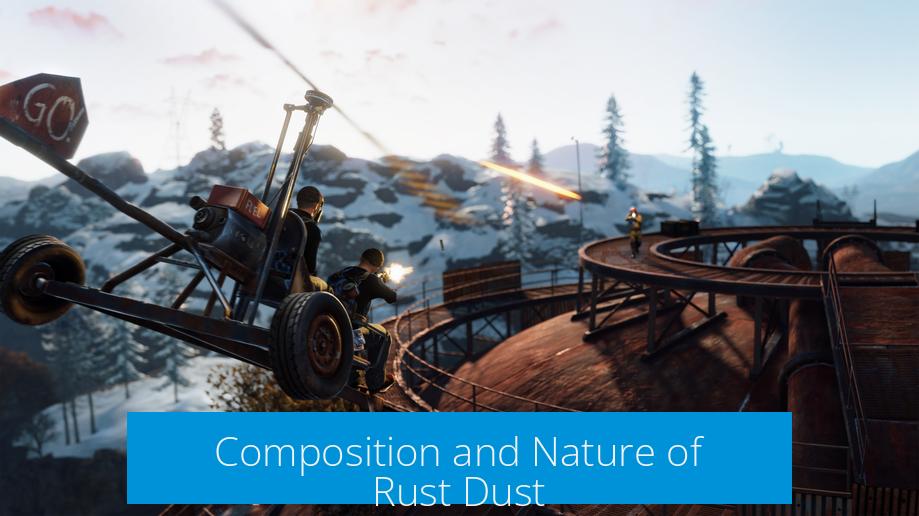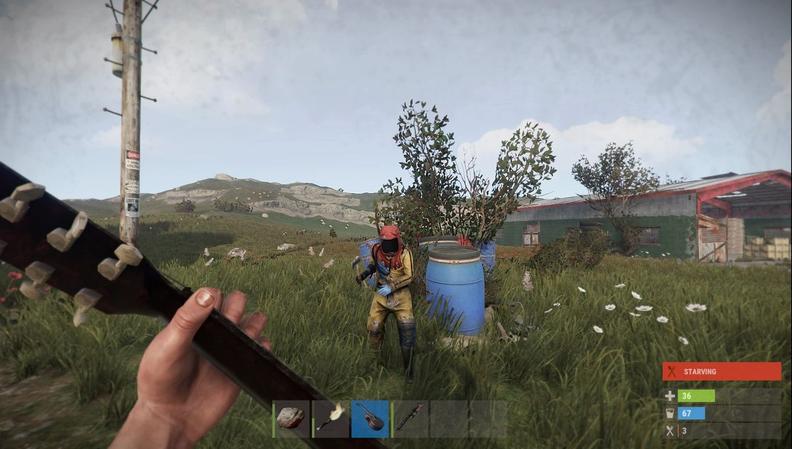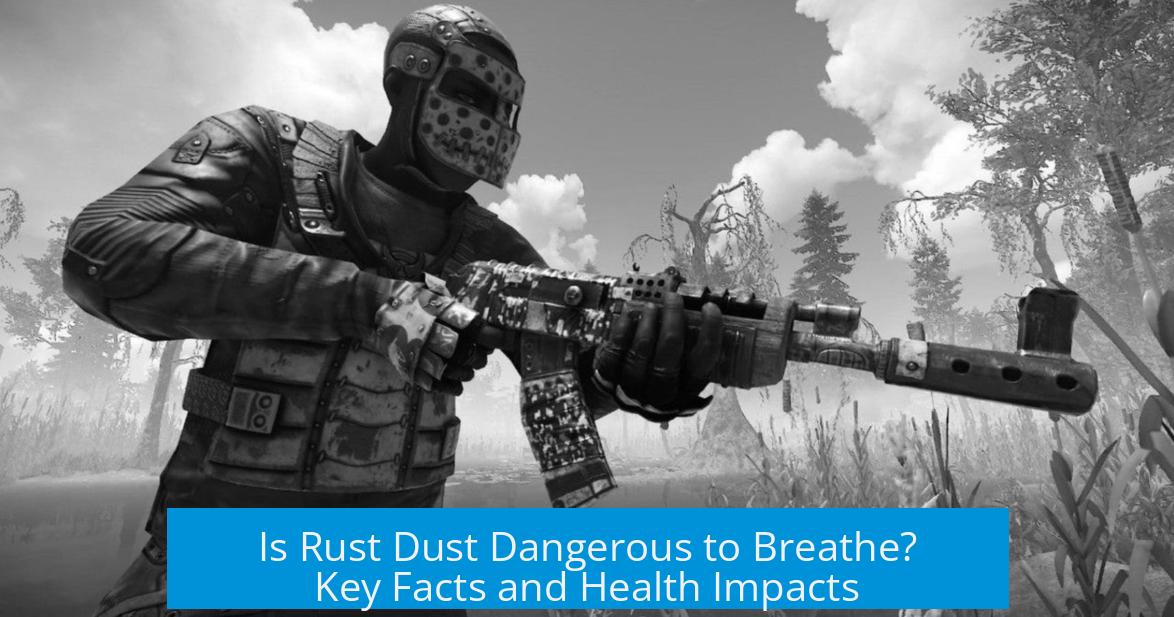Is Rust Dust Bad to Breathe In?

Yes, rust dust is bad to breathe in. Rust dust mainly consists of iron oxide but often carries other materials, including coatings from corroded metals. None of these substances benefit lung health. Breathing in rust dust can cause respiratory irritation and more serious health effects. Protective measures, such as wearing proper masks and eye gear, are essential when handling rust dust or working in dusty environments.
Composition and Nature of Rust Dust

Rust is primarily iron oxide, a compound formed when iron oxidizes on exposure to air and moisture. However, rust dust is not pure iron oxide. It may contain paint, protective coatings, and other contaminants from the corroded metal surface. Such particulates are irregular and likely mixed with various chemicals.
Because rust dust comprises fine particles, it easily becomes airborne during activities like sanding, brushing, or grinding rusted metal parts. Once airborne, these particles can enter the respiratory tract and affect lung health.

Health Impacts of Breathing Rust Dust
Inhaling any dust adversely affects respiratory function by irritating airways and lungs. Rust dust, having iron oxide particles and unknown coating residues, poses health risks. The dangers range from mild irritation to occupational diseases.

- Iron fume fever: Welders exposed to iron fumes can develop this condition, characterized by flu-like symptoms from inhaling iron oxide particles.
- Respiratory irritation: Rust dust may cause coughing, shortness of breath, and discomfort due to particulate matter irritating the lungs.
- More severe effects: Symptoms such as dizziness, lightheadedness, coughing blood, or chest pain suggest more serious lung or systemic issues and require medical attention.
While iron oxide dust is not classified among the most toxic dusts, any particulate inhalation can trigger harmful responses, especially in sensitive individuals or those with underlying lung conditions.
Symptoms Indicating Harm from Rust Dust

Some signs suggest a harmful effect from rust dust exposure:
- Persistent coughing, wheezing, or shortness of breath
- Chest pain or discomfort
- Dizziness or feeling faint
- Coughing up blood, which may signal severe lung damage
- Headaches or systemic symptoms possibly linked to blood oxygen changes
These symptoms indicate the need to reduce exposure immediately and seek evaluation from a healthcare provider.

Recommended Protective Measures
Protection is essential when working around rust dust. Several steps minimize health risks:

- Masks: Use a rated respirator mask such as N95 or FFP3 to filter fine particles effectively.
- Eye protection: Dust can irritate eyes; goggles or safety glasses prevent exposure.
- Gloves and hygiene: Wear gloves to prevent skin contact and wash hands before eating or touching the face.
- Ventilation: Work in well-ventilated areas or use exhaust systems to reduce airborne dust concentration.
- Hydration and breaks: Staying hydrated supports overall health during exposure.
Even disposable N95 masks provide decent particle filtration and help avoid inhaling harmful dust. Face fitting is recommended but, in many cases, proper fit can be achieved without professional fitting if the mask fits snugly on a clean-shaven face.
Other Factors Affecting Risk
Rust dust exposure often coincides with other hazardous substances. Mechanic shops and industrial settings may have chemical vapors, welding fumes, brake dust, solvents, and acids. These combined exposures can exacerbate health effects and complicate symptom diagnosis.
Therefore, evaluating overall environmental hazards is crucial. Dizziness or systemic symptoms might not be caused solely by rust dust but by interactions with other chemicals or poor working conditions.
Workplace and Attitude Toward Safety
Repeated exposure to rust dust and related particulates should be taken seriously. Workers should never underestimate risks based on others’ acceptance of hazards. Persistent use of personal protective equipment (PPE) safeguards long-term health.
Wearing masks or other PPE should not be viewed as inconvenient or unnecessary. Family and coworkers might mock, but prioritizing health remains essential. Protective gear use is a sound investment against chronic respiratory illnesses.
Summary Recommendations
- Rust dust contains iron oxide and other harmful particles; inhalation is harmful.
- Symptoms like coughing, dizziness, or chest pain require medical evaluation.
- Always wear an N95 or FFP3 mask when working with rust or brake dust.
- Protect eyes with goggles in dusty environments.
- Maintain good hygiene, wear gloves, and work in ventilated areas.
- Consider other environmental hazards that may worsen effects.
- Take dust exposure seriously and adopt a safety-first mindset.
Is Rust Dust Bad to Breathe In? The Rusty Truth You Need to Know
So, is rust dust bad to breathe in? Absolutely. It’s more than just dirty iron oxide particles drifting around. When you inhale rust dust, you’re not only sucking in iron oxide, but also a cocktail of other substances—like coatings, paints, and grime clinging to that rusty surface. None of that cocktail does your lungs any favors.
Let’s unpack this rusty mess together in plain English—and yes, there’s some mildly amusing yet serious insight coming your way.
What Exactly Is Rust Dust, Anyway?
Rust dust mostly consists of iron oxide, the flaky reddish-brown stuff you see on corroded metals. You might think, “Iron oxide—how bad can it be?” Well, while it’s not the worst dust you can breathe in, it’s far from harmless. The dust can also carry residues from old paint, coatings, and grease stuck on corroded parts.
Picture it like this: you’re not just inhaling a bit of rust but also the leftovers of everything that once coated that metal. Yes, that’s a creepy, lung-unfriendly dust cocktail.
Why Breathing Any Dust Is a Bad Idea—Including Rust Dust
Generally speaking, breathing in anything other than fresh air is a bad idea. Dust particles, no matter how innocent they look, can wreak havoc on your respiratory system. Rust dust isn’t an exception.
Have you heard of iron fume fever? It’s a classic occupational hazard for welders who breathe in iron oxide fumes. Symptoms include fever, chills, and respiratory discomfort—a clear signal your lungs are yelling, “Not cool!” That shows iron particulates can really mess with your body.
Rust dust’s not off the hook either. If you start feeling dizzy or nauseous when exposed, that’s your body waving a red flag.
Keep in mind: while rust dust might not cause chronic diseases like cancer or COPD directly, inhaling any kind of fine dust means you’re stuffing “stuff” where your lungs should stay clean. Over time, that’s just a recipe for trouble.
Rust Dust Stories From the Trenches
One turbo remanufacturer shared that the workspace was rusty and dusty, but a simple N95 mask kept the rust dust monsters at bay. Another person recalled warnings about iron oxide glaze use—breathing it was like breathing tiny nails. Now, imagine trying to breathe nails. That’s how harsh rust dust can be for your lungs.
Working on car brakes or scrubbing corroded parts without protection? That’s asking for trouble. The dust released can cause coughing, dizziness, or worse. So, if you’re a DIY warrior or shop mechanic, this info comes with your name on it.
Symptoms You Should Never Ignore
Wondering if you’re reacting badly to rust dust? Watch out for symptoms like dizziness, nausea, or feeling lightheaded when working near rusty parts. These signs mean the dust is likely affecting your brain and blood pressure.
If you’re coughing up blood or feeling constant lung pain—stop what you’re doing and see a doctor, pronto. That’s not just rust dust; it may be serious respiratory damage.
Sometimes, though, dizziness might be from dehydration or working in cramped, poorly ventilated spaces. So keep hydrated, make sure you have fresh air, and don’t blame dust right away—unless it hits you every time.
Could Something Else Be Causing Your Issues?
Rust dust isn’t the lone villain in dusty workshops. Shop air can be loaded with solvents, welding fumes, brake dust, and acids. For instance, brake dust was once laden with asbestos, a lung nightmare, and though asbestos isn’t common now, brake dust remains unhealthy.
So if dizziness or coughing is your gig, question what other dusts or chemicals you might be inhaling along with rust.
Protect Yourself—Because Rust Dust Doesn’t Play Nice
Here’s the golden nugget: wear a mask. It’s the easiest and cheapest defense you’ve got. An N95 mask, now widely accessible thanks to recent times, blocks out most dust particles. For tougher environments, a face-fitted FFP3 mask is even better—but keep it clean-shaven so it fits snug.
Eye protection is also non-negotiable. Dust in your eyes isn’t just annoying; it hurts and can cause infections or worse.
If you blast brake dust or rust off with compressed air, your mask and safety glasses become your best friends. Gloves aren’t just fashion statements either—use them, wash your hands before eating or touching your face.
And remember: Fitting your mask well isn’t just a fashion thing—it’s essential for protection.
Got a Buddy Who Mocks Your Mask? Here’s What to Say
If someone laughs at you for wearing a mask, toss this gem back: you’ll outlive them because you take smart risks. Tell them you’ll save a speech for their funeral, then suit up and stay safe. You’re protecting your lungs, brains, and life. The rest is just background noise.
Honestly, if they care more about being trendy than being healthy, that’s their problem. Blow some rust dust their way—not literally—and keep rocking that mask.
Final Rust Dust Survival Tips:
- Always wear at least an N95 mask or better when working near rust. It filters most harmful particles.
- Use eye protection—dust is an eye irritant and comes with its own risks.
- Dust is dust. All forms can hurt lung tissue over time. Avoid inhaling it if you can.
- Work in well-ventilated spaces. If it smells funny or you feel dizzy, get fresh air. Hydrate well.
- Pay attention to symptoms. If coughing, lung pain, or dizziness persist, see a doctor.
- Consider all the chemicals around you. Rust dust is just one of many risks.
- Gut check your risk tolerance. Don’t assume just one person’s acceptance of risk applies to you.
If rust dust is lurking in your life, there’s no excuse not to suit up and shield those lungs. Trust me, your future self will thank you for the extra breath of fresh air today.
Is rust dust harmful to breathe in?
Rust dust mainly contains iron oxide, which is not harmless. It can irritate your lungs and cause breathing issues. Other substances on rusty parts may add to the harm.
What symptoms suggest rust dust has affected my health?
Coughing, dizziness, lung pain, or feeling faint after exposure could mean rust dust is affecting you. If symptoms persist, it signals a problem.
Can breathing rust dust cause long-term lung diseases?
Rust dust may not directly cause chronic diseases like cancer, but inhaling dust harms your lungs. It might lead to conditions like iron fume fever in welders.
How can I protect myself from rust dust exposure?
Wear masks like N95 or FFP3 when working near rust dust. Eye protection and gloves are also important. Work in ventilated spaces and wash hands often.
Is rust dust exposure worse when mixed with other chemicals?
Yes. Rust dust combined with solvents, acids, or welding fumes can increase health risks. Be aware of your work environment’s chemical exposures.
Should I take dizziness or lung pain seriously after rust dust exposure?
Yes. Dizziness and lung pain are signs your body is reacting badly. These symptoms need attention and better protective measures.




Leave a Comment